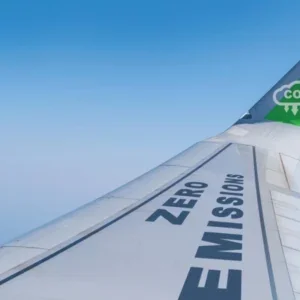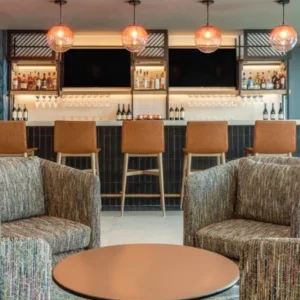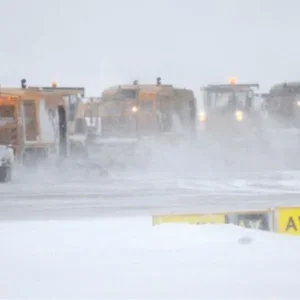Earning a spot on the list of carbon neutral airports carries a lot of sustainability clout. Not only does it reveal earnest commitment to safeguarding the environment, but it also positions the airport within a small circle of industry leaders. Only 28 airports in Europe are on the list, with Stockholm-Arlanda Airport being the first in 2009. There are another 118 aspiring to the same status by 2030. That’s a lot better than Asia, with four, and North America, with one.
A recent addition to the European carbon-neutral club is Gatwick Airport. Airports Council International (ACI) Europe recognised it in May, making it the first London airport to achieve this status. Gatwick launched its ‘Decade of Change’ programme in 2009 with earnest sustainability goals and enthusiastic financial targets. The programme focuses on carbon emissions, energy and water use, waste, public transport, air quality, noise, biodiversity and community engagement.
“The strategy is deliberately short, simple and ambitious,” says Rachel Thompson, the airport’s sustainability manager. This has been essential for creating deep awareness of sustainability across the business. “Managers and staff are able to relate their day-to-day and year-round activities to the ‘Decade of Change’ goals.”
Neutral state
Earning neutrality was not easy, but it included a 5% reduction in annual carbon emissions from fuel and energy, a 2.6% drop in annual energy consumption per passenger, operating below air quality limits for NO2 and PM10, and locally sourcing employees and suppliers. However, the airport’s focus has stretched to include ridding itself of waste. It currently sends zero untreated operational and commercial waste to landfill. It has also set a precedent in the aviation community as the first airport to build a Category 1 waste plant.
The £3.8-million plant deals with airline cabin food waste, and any packaging, cups and meal trays mixed with it. Gatwick generates around 10,500t of waste a year and roughly a fifth of this falls into Category 1. The new plant can process around 10t a day or 3,650t a year. All of the energy goes back into the facility with 60–70% used to dry the waste for the next day and the remainder to heat the site.
“We brought responsibility for sorting waste in-house to maximise the recycling rate – hitting 64% in June 2017, the highest for a UK airport,” Thompson says. “This initiative arose from recognition in the operations team that incremental progress on our waste goals had run its course and it was time to innovate.”
The biomass produced is currently used for heating the recycling plant, but Thompson says there are other heating uses being evaluated. The North Terminal could benefit from the plant’s capacity, which in principle could provide between 20 and 50% of its heating requirements, depending on the weather.
Installation and implementation of the plant within the existing airport waste centre’s footprint has presented a few complex operational challenges, but Thompson is confident the ‘zero waste to landfill’ target will continue even as passenger numbers grow.
Past successes suggest Thompson’s team needn’t worry. While more aircraft take off and land at Gatwick, and annual passenger numbers have increased from 31 million to 43 million between 2010 and 2016, the airport’s current environmental footprint today is roughly the same as it was seven years ago. The plant, which is only a few months old, will lead to further sustainability goals as it matures. Simply processing waste on-site results in 50% fewer lorry journeys to external waste plants.
It’s complex and costly – at least for initial layout of technology and facilities to make airports more sustainable – even for large hubs such as Gatwick. Many smaller airports, with less money to go around, have to employ cheaper alternatives in order to stay green.
Big goals
While Keflavík International Airport in Iceland is smaller than Gatwick, with fewer than five million passengers each year, it has big plans. Isavia, which runs Keflavík, launched its master-plan in 2015; it is set to culminate at the end of 2040.
The long-term strategy makes growing the tourism sector a priority. According to the country’s tourism plan, income from the sector will climb from ISK350 billion ($3.3 billion) in 2015 (28% of the country’s total foreign currency revenue in the same year) to ISK620 billion in 2020 and over ISK1,000 billion by 2030.
Tourist numbers are projected to rise and 97% of foreign tourists arriving in Iceland already enter through Keflavík International Airport. Expansion is set to continue to accommodate this influx. There are plans for a bigger terminal, hotels, more parking lots, new buildings for the handlers and companies working at the airport, and additional hangars for aircraft.
With all this growth, an important question arises: how can the airport optimise its impact on Iceland in general, as well as the local community? Björn Óli Hauksson, Isavia’s CEO, is tasked with finding the right answer. “It’s an enormous change, so we have to be very careful about how we operate. Keflavík is located in a small community. There are only 20,000 people living around the airport,” he says.
In determining the best solution, the airport has begun, and will continue, to address the social and economic changes in the area. “Community engagement is very important,” Hauksson says, echoing the sentiment held at Gatwick. “We have to discuss and forewarn the community that due to the growth of the airport, they can foresee a lack of housing, schools, kindergartens and so on. Simple things about handling waste and the community can be different. They could experience lack of staff in certain sectors, because they are getting jobs at the airport. So there are a lot of things to think about.”
Those are the potential causes of stress, but there are also the positive aspects. In 2006, the US Navy left Keflavík, leading to an economic downturn in the area. The airport’s expansion and resulting employment has “turned it around, so the community is much lighter now than it was a few years ago”, according to Hauksson.
Closely intertwined with social and economic issues is the need to safeguard the environment. Iceland, and Keflavík airport as a result, is unique, as it produces much of its energy through renewable sources – particularly hydro and geothermal. Two tectonic plates run through the island, resulting in volcanoes and magma to fuel geothermal power plants.
The airport has been using geothermal energy for nearly four decades. One of Iceland’s major geothermal plants, in Svartsengi, is also one of the nation’s biggest tourist attractions. The Blue Lagoon is a hotspot for visitors and an energy hub for locals.
Hauksson admits to the uniqueness of this dual purpose but for him, as with many Icelanders, geothermal power is a source of pride, compared with the 1950s, when imported coal burnt black clouds into the sky. “The power plant produces hot water for heating as well as electricity, while promoting the tourist industry, so everything is used,” Hauksson says. “The good thing for us is energy is not an issue. For buildings, we have no problems with carbon neutrality, so for us the renewable part of the discussion these days is looking into electric cars and using methane gas from landfills.”
Ditching fuel and switching to electric vehicles began a little over a year ago at Keflavík. The company has decided to sell all its methane cars and has started purchasing electric cars, a process that will be completed over a few years, according to Hauksson.
Keflavík has also joined ACI Europe’s voluntary carbon accreditation programme to reduce emissions. It has earned a Level 1 accreditation, sharing the recognition with more than 100 airports in Europe. The four levels of accreditation are mapping, reduction, optimisation and neutrality. Level 1 refers to the work Hauksson has been talking about: analysing the airport’s environmental impact on its surroundings and measuring its carbon footprint.
On the buses
Sustainably run vehicles are an increasingly proactive means of cutting carbon emissions. Cities such as Bologna, Oslo, Trondheim, Zurich, Frankfurt and Paris are ridding themselves of diesel-powered buses and maintenance vehicles, and choosing electric, hybrid or gaspowered ones. This is also part of Gatwick’s plan for a sustainable transport. An electric and hybrid taxi agreement to transport passengers between terminals and aircraft will lead to a 75% reduction in emissions.
Gatwick has partnered with Bluecity from the Bolloré Group, which has implemented electric charging points and an electric car-sharing scheme throughout London and Paris. Thompson calls it “potentially gamechanging for air pollution” and hopes London can achieve what Paris did. Also adding to sustainable transport infrastructure is the £6.5-billion Thameslink upgrade, which will be completed in 2018. Thomson says trains will leave Gatwick for London with “Tube-like frequency every three minutes”.
Electric cars, renewable energy and recycled waste are vital tools for building a sustainable future. But criticism persists that despite airports painting themselves green, aircraft are the real polluters – especially when it comes to noise.
There are controls in place to help drive change among manufacturers. Gatwick has persuaded major operators to modify engines in their Airbus with a fuel over pressure protector (FOPP) to remove a particular source of noise disturbance. The airport will impose higher charges on those that have not complied by January 2018.
Thompson is more confident in manufacturers’ desire to change. “The pace of aviation R&D is considerable. The new A320neo, for example, reduces aircraft noise by 50% and emissions by 15%. easyJet has ordered 130 of these, with the first two already flying from Gatwick and Luton,” he says.
Thompson and Hauksson talk about the industry’s shared responsibility to protect the environment. Citing Sustainable Aviation and ACI Europe, the pair believe positive change is happening and will only move faster.
Thompson says Gatwick was motivated by Manchester Airport’s carbon neutrality and is committed to passing the knowledge to other airports through tours of its waste plant and collaboration on sustainability. “I think all UK airports recognise it makes good economic, environmental and ethical sense to improve their sustainability credentials, and many are well on the way down this road,” she says.
While Keflavík is not yet carbon neutral, Hauksson would no doubt consider the airport already walking along Thompson’s metaphorical road. “We are very lucky we are in a place where renewable energy already plays a huge part, but we aim to continue being better. I think we will see a very sustainable future in terms of energy at Keflavík and also at other Isavia airports,” he says.
The carbon-neutral list is aspirational, and takes a lot of investment and planning to get your name on it. However, these targets push the industry, even while it continues to grow, to do more to protect the environment. Nurturing sustainability goals within long-term strategies will lead to great things. As Thompson suggests, in another 15 years, electricity at airports mightn’t just be for lighting and charging cars. It could well be used to power electric-hybrid short-haul aircraft.






